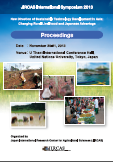Technology of Producing Teak Timber for Farmers in Thailand: Toward Sustainable Management

Teak, Tectona grandis L. is the premier high quality cabinet wood of the world, and the decline of
natural resources and prudent management objectives, as well as the desire to develop valuable resources
turned man’s attention to its artificial culture in plantation. In the world, teak plantations have been
developed in 36 or more nations including native countries such as Thailand, and form 75% of the fine
quality tropical tree species plantation areas as of 2000. In general, planting teak would be profitable.
In Thailand, forest areas decreased drastically due to conversion into agricultural lands amidst the
remarkable economic development. The forests which accounted for 53% of the country’s total areas in
1961 decreased to 26% in 1993, and most sharply decreased from 42 to 13% in northeast Thailand. On the
critical forest situation including lack of domestic timber, the Royal Forest Department (RFD) started the
subsidiary reforestation projects in 1994 in order to promote the reforestation of indigenous economic tree
species such as teak in private farmlands. The teak plantation area by 2001 accounted for 45%, 150,000
hectares among the whole reforested area of 350,000 hectares. However, 56.8% of the whole reforested
area was converted to other land use of cash crops, para rubber etc., because some farmers were disappointed
with poorer growth of teak than supposed; couldn’t wait for 10 or more years without benefits before teak
harvesting. Many factors affected the success of teak planting programmes including sites etc. Thus, what
could prompt farmers to keep their motivation for sustainable teak plantation management were required.
JIRCAS has carried out a joint research project with RFD in order to back up farm forestry management
involving teak, and has contributed to the improvement of local livelihood since 2006. The research
project focuses on the development of technologies for farmers such as future resource and profitability
evaluation including suitable site selection, high productivity including low cost regeneration. A study site
was set in northeast Thailand.
As for the future resource and profit evaluation, a yield table for teak plantation in northeast Thailand
was developed as a tool for estimating future teak tree size and growing stock. Also, a soil suitability map
for teak plantation in Udon Thani and Nong Bua Lam Phu Provinces was developed. Farmers could
estimate their future yield by the combined usage of the soil suitability map and the yield table. The map
currently covers only two provinces, 1.5 million hectares, but the know-how will be made available in
order to extend map coverage to other provinces.
As for the profitability evaluation tool of teak farm forestry, a simulation system with discounted cash
flow analysis was constructed. Since the conditions on site area, site quality, household economy etc.
varies by farmer, management treatments vary in plant spacing, weeding, fertilization and others. The
simulation system can contribute to explore better choice of treatment for increase in profitability. Recent
study shows that a 20-year rotation (cutting cycle) is generally preferable to a 15-year case, especially at
the sites of medium quality; spacing 2 x 4 m is better than 4 x 4 m at the sites of good quality in any of
15- or 20-year rotation, but 4 x 4 m is better at the sites of medium quality.
As for the low cost regeneration method, coppicing is supposed to be effective, because coppicing
improved the initial-year balance of payments by 50% or more through a simulation study. However, an
experimental study on how to control sprouts from a stump should be continued.
As for the high profitability technology, thinning is the most effective to control tree growth and stem
quality. But the previous studies on teak plantations were not conducted enough, and our experimental
study about thinning effects on teak growth is still going on in ratio and schedule of thinning at least
several years. In the next step, the yield table which doesn’t involve thinning effects, will be revised to
consider a case with thinning treatment.
In international frameworks, REDD-plus (reducing emissions from deforestation and forest degradation
in developing countries; and the role of conservation, sustainable management of forests and enhancement of forest carbon stocks in developing countries) is becoming a more important machanism. An evaluation
technology of carbon accumulation capacity of popular indiginous tree species as teak in Thailand is also
studied under the joint research project. Because it would be able to contribute towards motivating farmers
or local people to manage their forest through the REDD-plus mechanism.
| Date of issued | |
|---|---|
| Creator | Iwao Noda |
| Subject |
Tectona grandis L. farm forestry profitability sustainable plantation management |
| Publisher | Japan International Research Center for Agricultural Sciences |
| Available Online | |
| Issue | 2013 |
| spage | 136 |
| epage | 144 |
| Rights | Japan International Research Center for Agricultural Sciences |
| Language | eng |
